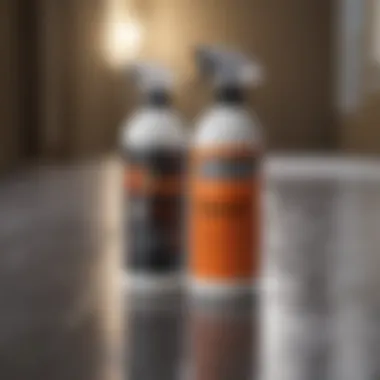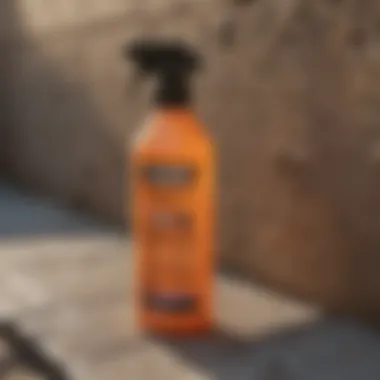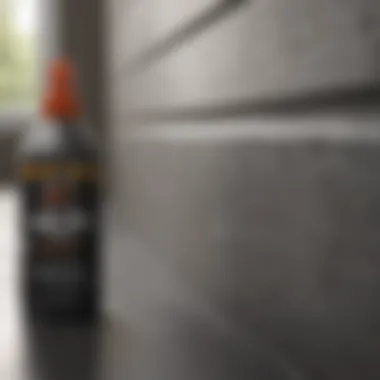Discover Advanced Wall Sealant Solutions for Bug Prevention: A Comprehensive Guide


Preventive Pest Control Strategies
When it comes to preventing pests from invading your home, it's crucial to implement robust strategies that cover all angles. One essential aspect of preventive pest control is focusing on safeguarding your house's exterior. This includes expert tips for effectively sealing cracks in walls and windows to create a barrier that deters bugs from entering your living space. Additionally, clearing debris such as leaves and woodpiles around your home's perimeter is crucial in eliminating potential hiding spots for pests. Furthermore, preventing pests from entering can be achieved by sealing gaps around doors and windows with suitable materials to fortify your home's defenses.
Maintaining your yard is another key component in the fight against pests. By adhering to essential yard care routines such as regular mowing, trimming bushes, and removing standing water, you can significantly reduce the attractiveness of your yard to pests. Implementing methods like installing barriers or using natural repellents can help in keeping your yard pest-free and creating a deterrent for insects and animals.
Ensuring indoor cleanliness is paramount for pest prevention within your home. Adopting expert cleaning tips and techniques, such as regular vacuuming, sweeping, and disinfecting surfaces, can go a long way in keeping pests at bay. Additionally, maintaining a pest-resistant indoor environment involves sealing food containers tightly, fixing leaky pipes promptly, and ensuring trash is disposed of in secure bins to minimize attractants for pests.
Effective garbage disposal also plays a significant role in pest control. Implementing efficient waste disposal methods, such as using sealed trash cans and composting bins, helps in reducing the likelihood of attracting pests to your property. Proper garbage disposal practices not only prevent pests but also contribute to a hygienic living environment for you and your family.
In addition to these fundamental strategies, there are innovative ways to safeguard your home from pests. Incorporating techniques like installing motion-activated lights, using sound repellents, and introducing natural predators can all contribute to creating an inhospitable environment for pests. By combining various preventive measures, you can enhance the overall resilience of your home against potential pest invasions.
Understanding the Need for Wall Sealants
In this comprehensive guide on Advanced Wall Sealant Solutions to Combat Bugs, the importance of understanding the need for wall sealants cannot be overstated. Proper sealing of walls is a fundamental aspect of bug prevention strategies, providing a barrier that deters insects from entering living spaces. By delving into this topic, readers will grasp the pivotal role that wall sealants play in mitigating bug infestations and maintaining a pest-free environment. Furthermore, the meticulous application of wall sealants can offer long-term benefits by ensuring structural integrity and safeguarding indoor air quality.
The Impact of Bugs on Household Environments
Bug infestations can pose a multitude of risks to household environments, making it imperative to address this issue promptly. Potential risks associated with bug infestations include structural damage to properties, contamination of food sources, and transmission of diseases. This subsection explores in depth the various detrimental effects that bug infestations can have on health and hygiene within a home setting. By elucidating the specific consequences of bug presence, readers will gain a deeper understanding of the urgency in implementing bug prevention measures.
Potential Risks Associated with Bug Infestations
The presence of bugs in a household can lead to a range of detrimental consequences. From structural weakening due to burrowing activities to food contamination resulting in potential health hazards, bug infestations can jeopardize the sanctity of living spaces. By highlighting these risks, individuals can better appreciate the significance of investing in effective bug prevention solutions that prioritize sealing vulnerabilities.
Effects on Health and Hygiene
Beyond physical property damage, bug infestations can also impact the health and hygiene of residents. Allergies, respiratory issues, and the spread of pathogens are among the potential health risks associated with bug presence. Maintaining a clean and bug-free indoor environment is essential for preserving the well-being of occupants. This subsection underscores the critical importance of addressing bugs from a health and hygiene standpoint.
Benefits of Wall Sealants in Bug Prevention
Wall sealants offer a proactive solution to bug prevention, delivering a range of benefits that contribute to creating a fortified barrier against insect ingress. Enhanced structural integrity is a key advantage of using wall sealants, as they reinforce the stability of walls and prevent insect infiltration. Additionally, wall sealants play a crucial role in improving indoor air quality by sealing off potential entry points for bugs and external pollutants.


Enhanced Structural Integrity
A notable benefit of applying wall sealants is the enhancement of structural integrity within the home. Sealants act as a barrier against moisture ingress and pest intrusion, preserving the longevity of walls and overall structural stability. This section elaborates on how enhanced structural integrity contributes to bug prevention strategies and underscores its significance in maintaining a robust indoor environment.
Improved Indoor Air Quality
Sealants not only bolster structural strength but also contribute to enhancing indoor air quality. By sealing off gaps and crevices that bugs could exploit for entry, wall sealants help in maintaining a healthier indoor environment free from allergens and pollutants. The subsection delves into how improved indoor air quality is a direct result of efficient bug prevention through the application of suitable wall sealants.
Types of Wall Sealants for Bug Control
Wall sealants play a crucial role in bug control within households by forming a protective barrier that prevents bugs from entering through cracks and crevices. Selecting the right type of wall sealant is essential for effective bug prevention strategies. By understanding the specific characteristics, benefits, and considerations of different sealants, homeowners can make informed decisions to safeguard their living spaces from unwanted intruders.
Silicone-Based Sealants
Silicone-based sealants offer exceptional adherence to various surfaces, including walls, ceilings, and corners. This unique characteristic ensures a tight seal that effectively blocks bug entry points. The flexibility of silicone sealants allows them to adapt to minor movements in the building structure, preventing gaps from forming over time. This flexibility is advantageous in bug control as it maintains a solid barrier without compromising durability. While silicone sealants are popular for their waterproof properties, they may require additional care during application to ensure proper bonding and sealing.
Acrylic Sealants
Acrylic sealants are known for their quick-drying nature, making them a convenient choice for bug control projects that require swift completion. Their ability to dry rapidly reduces the waiting time between application and further pest management efforts, increasing overall efficiency. Additionally, acrylic sealants are paintable, allowing homeowners to customize the appearance of sealed areas for enhanced aesthetics. The paintable nature of acrylic sealants not only serves a functional purpose but also contributes to the visual appeal of the treated surfaces.
Polyurethane Sealants
Polyurethane sealants provide durable and long-lasting protection against bugs due to their robust nature. These sealants form a tough barrier that effectively seals off potential entry points for insects, offering prolonged security for households. Furthermore, polyurethane sealants exhibit excellent resistance to various weather elements, making them suitable for both indoor and outdoor bug control applications. While polyurethane sealants offer robust protection, their application may require precision to ensure uniform coverage and seamless integration with existing surfaces.
Application Techniques for Wall Sealants
In this section of the article, we delve deep into the critical topic of Application Techniques for Wall Sealants, which plays a pivotal role in ensuring the effectiveness of bug control methods in households. Utilizing the right application techniques is essential to achieve a proper seal that prevents bugs from entering a space. One of the key benefits of focusing on application techniques is the ability to create a protective barrier that hinders bug infiltration, safeguarding the structural integrity of a building. Aspects such as the method of application, coverage uniformity, and choice of tools greatly influence the overall success of bug prevention through sealants.
Surface Preparation
Cleaning and Priming
Cleaning and priming are fundamental steps in the surface preparation process before applying sealants. A thorough cleaning ensures the removal of dirt, dust, and debris that could hinder the sealing process. By priming the surface, adhesion between the sealant and the wall is enhanced, promoting long-term durability. This meticulous cleaning and priming procedure is a crucial element in achieving a secure and long-lasting seal to combat bugs effectively. The unique feature of this process lies in its ability to create an optimal surface for sealant adhesion while also providing a clean canvas for application. The advantages of proper cleaning and priming include improved adhesion, reduced risk of sealant failure, and enhanced bug prevention efficacy.


Assessment of Cracks and Crevices
In assessing cracks and crevices, the focus is on identifying potential entry points for bugs and determining the extent of sealing required. This step involves a detailed inspection of the surfaces to pinpoint vulnerable areas where bugs could infiltrate. Understanding the unique characteristics of each crack and crevice allows for a customized sealing approach that addresses specific vulnerabilities. By targeting and sealing these entry points effectively, the overall bug prevention strategy is strengthened. The distinct feature of assessing cracks and crevices lies in its tailored approach to sealing, which enhances the precision and effectiveness of bug control. Advantages include targeted bug exclusion, improved structural integrity, and enhanced indoor comfort facilitated by thorough sealing of potential bug entry points.
Factors to Consider When Selecting a Wall Sealant
When delving into the realm of wall sealants designed to combat bugs, understanding the critical factors to consider when selecting the right sealant becomes paramount. The choice of wall sealant can significantly impact the effectiveness of bug prevention measures within a household environment. Factors such as compatibility with bug prevention strategies, longevity, durability, and maintenance requirements play a crucial role in ensuring the optimal performance of the sealant.
Selecting a wall sealant that seamlessly integrates with pest control strategies is vital for cohesive bug prevention. The compatibility of the sealant with existing pest control measures enhances the overall efficacy of bug prevention within the household. By choosing a sealant that complements pest control strategies, homeowners can establish a comprehensive defense system against bugs, ensuring a proactive approach to maintaining a bug-free environment.
The ability of a wall sealant to effectively seal tiny openings is another key consideration when selecting the right product. Sealants with superior sealing properties can effectively block off entry points for bugs, preventing their intrusion into living spaces. The capability to seal tiny openings ensures a thorough defense mechanism against various types of bugs, including ants, spiders, and cockroaches. Homeowners can benefit from the sealant's ability to create a barrier that restricts bug infiltration, safeguarding the household from potential infestations.
Compatibility with Bug Prevention Measures
Integration with Pest Control Strategies
Integration with pest control strategies is a pivotal aspect of effective bug prevention within residential settings. The synergy between wall sealants and pest control measures strengthens the overall defense mechanism against bugs. By ensuring that the sealant aligns with existing pest control strategies, homeowners can establish a comprehensive bug prevention system that addresses vulnerabilities and potential entry points for bugs.
The key characteristic of integration with pest control strategies lies in its ability to complement and enhance the efficacy of bug prevention measures. This integration promotes a holistic approach to bug control, combining the strengths of both sealants and pest control methods to create a robust barrier against bugs. The seamless coordination between sealants and pest control strategies maximizes the effectiveness of bug prevention initiatives within the household.
One unique feature of integration with pest control strategies is its adaptive nature, allowing homeowners to customize bug prevention solutions based on specific pest threats. By tailoring the integration according to prevalent bug issues, homeowners can implement targeted strategies that address the unique challenges posed by different types of bugs. This flexibility empowers homeowners to proactively combat bug infestations, enhancing the resilience of their bug prevention measures.
Ability to Seal Tiny Openings
The ability of a wall sealant to seal tiny openings plays a crucial role in fortifying homes against bug infiltrations. Sealants that can effectively seal small cracks and crevices serve as a formidable barrier against bugs seeking entry into living spaces. By sealing tiny openings with precision and efficacy, the sealant prevents bugs from accessing indoor environments, thus safeguarding the household against potential infestations.
The key characteristic of the ability to seal tiny openings lies in its capacity to create airtight seals that inhibit bug penetration. Sealants with advanced sealing properties can target minute gaps and imperfections in walls, ceilings, and floors, effectively thwarting bug entry routes. By possessing the capability to seal tiny openings, the sealant acts as a proactive defense mechanism that reinforces the structural integrity of the home and prevents bug intrusions.
One unique feature of the ability to seal tiny openings is its versatility in addressing diverse bug ingress points. Whether dealing with microscopic gaps around windows, doors, or utility penetrations, the sealant's adaptive sealing ability ensures comprehensive coverage of potential bug entryways. This versatility enables homeowners to combat bugs effectively, significantly reducing the risk of infestations and preserving the hygienic standards of the household.
Longevity and Durability


Resilience to Environmental Factors
The resilience of a wall sealant to environmental factors is a vital consideration when selecting a bug control solution. Sealants that exhibit high resilience to environmental elements such as sunlight, moisture, and temperature fluctuations provide long-lasting protection against bugs. The ability of the sealant to withstand external stressors ensures that its bug-repellent properties remain effective over an extended period, contributing to sustainable bug prevention within the household.
The key characteristic of resilience to environmental factors lies in the sealant's capacity to maintain its structural integrity and bug-resistant properties under challenging environmental conditions. Sealants that are resistant to UV rays, water intrusion, and temperature variations offer durable bug control solutions that are not compromised by external factors. By possessing high resilience to environmental stresses, the sealant guarantees continuous bug protection, thereby establishing a reliable defense system against infestations.
One unique feature of resilience to environmental factors is its role in enhancing the longevity of bug control measures. Sealants that can endure harsh environmental conditions without deterioration ensure sustained bug prevention efficacy, minimizing the need for frequent reapplications. The sealant's ability to withstand environmental challenges prolongs its lifespan and maximizes its bug-repellent performance, making it a dependable choice for long-term bug control solutions.
Maintenance Requirements
The maintenance requirements of a wall sealant are essential factors to evaluate when seeking a bug control solution that offers lasting durability. Sealants with minimal maintenance needs reduce the time and effort associated with upkeep, providing homeowners with a convenient bug prevention option. Understanding the maintenance requirements of a sealant enables homeowners to ensure its continued efficacy in repelling bugs and maintaining a bug-free environment.
The key characteristic of maintenance requirements lies in the sealant's ability to retain its bug control properties with minimal maintenance interventions. Low-maintenance sealants that do not require frequent reapplications or specialized upkeep procedures offer practical bug prevention solutions for busy households. By selecting a sealant with manageable maintenance requirements, homeowners can streamline bug control efforts and focus on other aspects of household maintenance.
One unique feature of maintenance requirements is the sealant's long-lasting performance without extensive upkeep, ensuring sustained bug protection with minimal intervention. Sealants that adhere well and maintain their bug-resistant properties over time without significant maintenance efforts provide a hassle-free bug prevention solution. The ease of maintenance associated with the sealant contributes to its appeal as a durable and reliable bug control option that harmonizes with the practical needs of homeowners.
Tips for Effectively Using Wall Sealants Against Bugs
When it comes to battling bugs, proper application and maintenance of wall sealants play a crucial role in fortifying your home against unwanted intruders. The significance of effectively using wall sealants in bug prevention cannot be overstated. By following some essential tips, you can enhance the longevity and efficiency of your sealants, providing a robust defense mechanism against bugs.
Regular Inspection and Maintenance
Monitoring Vulnerable Areas
Monitoring vulnerable areas within your living space is a vital practice to identify potential entry points for bugs. By regularly inspecting areas prone to infestations, such as cracks, crevices, and openings, you can proactively prevent bug invasions. The key characteristic of monitoring vulnerable areas lies in its preventive nature, allowing homeowners to address vulnerabilities before bug problems escalate. This proactive approach not only aids in bug control but also maintains a healthier living environment free from pest-related concerns.
Prompt Repair of Damaged Sealant
Prompt repair of damaged sealants is essential to uphold the integrity of your bug defense system. When cracks or imperfections are found in the sealant, swift action must be taken to rectify these issues. The key characteristic of prompt repair lies in its ability to seal off potential entry points for bugs, ensuring that your home remains secure and bug-free. By promptly addressing any sealant damage, you prevent bugs from exploiting weaknesses in your protective barrier. This proactive maintenance approach contributes significantly to the long-term effectiveness of wall sealants against bugs.
Consultation with Professionals
Seeking Expert Advice
Seeking expert advice from pest control professionals can provide valuable insights into effective bug prevention strategies. The key characteristic of seeking expert advice is the tailored and specialized recommendations that professionals can offer based on individual home requirements. By engaging with experts in the field, homeowners can access customized solutions that address specific bug-related concerns, enhancing the overall efficacy of their bug control measures.
Professional Application Services
Professional application services offer homeowners the convenience and expertise required to ensure optimal bug protection. The key characteristic of professional application services is the precision and thoroughness with which sealants are applied by trained professionals. By entrusting the application process to certified experts, homeowners can guarantee that their sealants are installed correctly and efficiently, maximizing their bug-prevention benefits. The unique feature of professional application services lies in the comprehensive coverage and expertise provided, offering homeowners peace of mind and superior bug defense.



